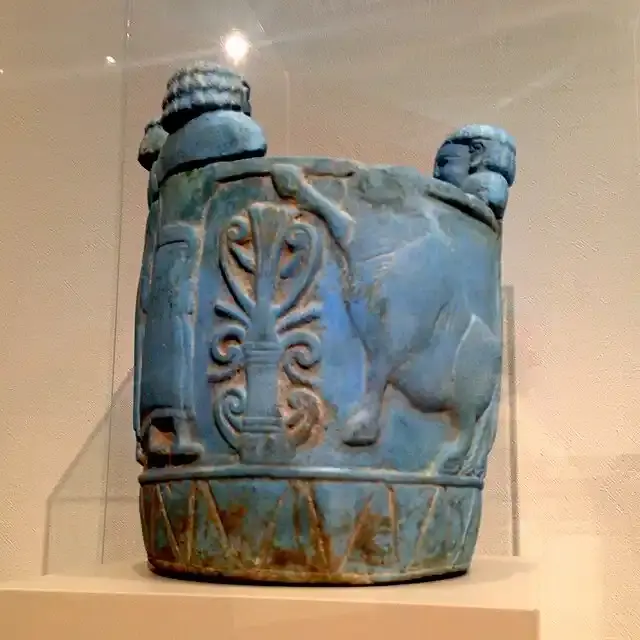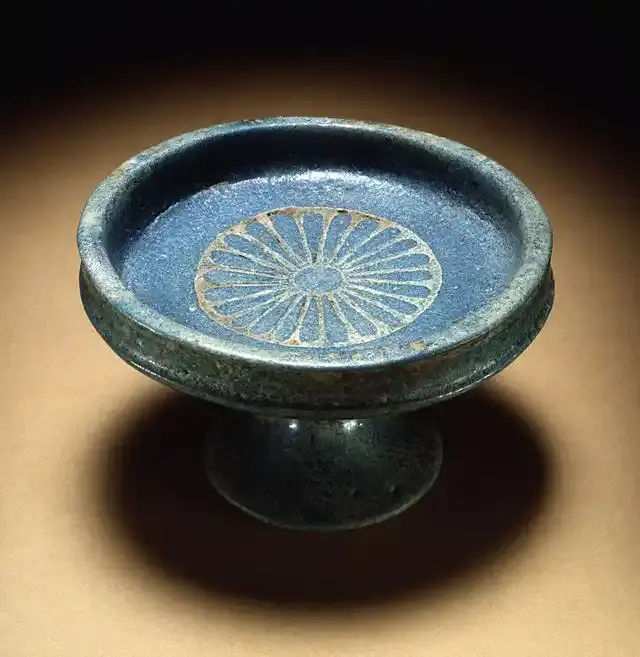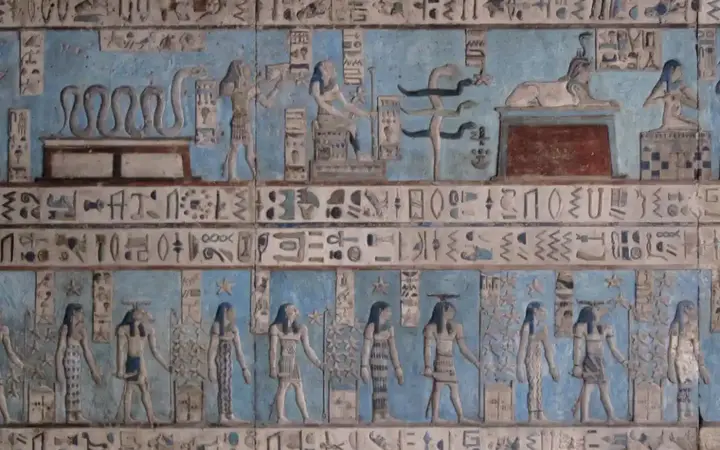The Historical Arch of Egyptian Blue: A Journey Through Time
Egyptian blue is often considered the world's first artificial dye, and has a history as rich and vibrant as its color. This attractive blue pigment was developed in ancient Egypt more than 4,500 years ago and has become a symbol of artistic and technological creativity. His story is a story of invention, adaptation and lasting impact, spanning civilizations and centuries. In this article, we will explore the appearance, composition, development, use, and spread of Egyptian blue, along with its current status and future potential.
1. The appearance of Egyptian blue.

The origins of Egyptian blue date back to the early dynasties of ancient Egypt, circa 2500 BC. During this period, artisans, seeking to replicate the vibrant shades of blue found in nature, discovered the composition of this unique pigment. Unlike natural metals such as lapis lazuli, Egyptian blue was synthesized through a deliberate process. It soon became a favorite color in Egyptian painting, used to depict gods, kings, and the afterlife.
Recommend
2. Egyptian blue components and composition.

Egyptian blue is a copper-based pigment, chemically known as copper and calcium silicate (CaCuSi4O10). Its manufacture involves heating a mixture of silica (sand or quartz), copper compounds (such as malachite or copper ore), lime (calcium oxide), and a small amount of alkali (such as natron or plant ash) at temperatures between 800 and 1,000 °C. The resulting compound is then ground into a fine powder, which can be used as a dye in paints or as a material for inlay and other decorative applications.
3. Development of Egyptian blue.
The development of Egyptian Azraq was not only a technical achievement, but also a testament to the ingenuity of ancient Egyptian artisans. Over time, the production process was perfected, ensuring the consistency and vitality of the dye. As a result of its stability and luster, this dye became a precious material, and its production techniques were closely protected secrets within artisanal communities. Egyptian blue was used in a variety of forms, from fine powder ground for detailed artwork to coarser grain to create mosaic tiles.
4. Egyptian Blue uses and applications.

Egyptian blue had a wide range of applications in ancient Egyptian society. It is commonly used in tomb paintings, symbolizing the divine and eternal, and reflecting the Egyptians' belief in the afterlife. This pigment also decorated the walls of temples, statues and artifacts, giving them a kind of holiness and immortality. It was also used in the production of glazed ceramic vessels, and in the making of beads, amulets and other decorative elements. The shine of this pigment under certain lighting conditions has led to its widespread use in jewelry and personal decorations.
5. The spread of Egyptian blue across different civilizations.
The appeal of Egyptian blue extended far beyond the borders of ancient Egypt. As trade routes expanded and cultural exchanges increased, this pigment spread to neighboring civilizations. It has been found in archaeological artifacts in ancient Mesopotamia, Greece and Rome, and even in places as far away as India and China. In these areas, Egyptian blue was often associated with prestige and wealth, and was used to decorate luxury goods and sacred objects. The appearance of this pigment in the Roman Empire was particularly noteworthy, as it was used in frescoes, mosaics and glasswork.
6. The decline of the Egyptian blue and its rediscovery.
The use of Egyptian blue began to decline after the fall of the Roman Empire, as newer pigments such as lapis lazuli, derived from lapis lazuli, and later artificial blue such as Prussian blue became more popular. For centuries, knowledge of how to prepare Egyptian blue has been lost, and its secrets have been buried in the ruins of ancient civilizations. It was not until the nineteenth century that the Egyptian blue was rediscovered, with the advent of modern archaeology. Analysis of ancient artifacts revealed the unique composition of the pigment, reigniting interest in its history and production techniques.
7. The current situation of Egyptian blue.
Today, Egyptian blue is more than just a historical curiosity. He has found new life in the fields of art conservation, archaeology and materials science. Thanks to its unique properties, especially its ability to shine under infrared light, it has become invaluable in the study of ancient artworks, allowing researchers to discover hidden layers of paint and original compositions. In addition, the stability and non-toxicity of the pigment led to its use in modern art restoration projects, where it enables the accurate reproduction of ancient techniques.
8. The future of Egyptian blue.

The future of Egyptian blue lies at the intersection of art, science and technology. Researchers are exploring the potential of this pigment in various fields, from nanotechnology to biomedical applications. Infrared fluorescence has opened up possibilities in imaging techniques, as it can be used to enhance the accuracy of medical imaging devices. Moreover, the study of Egyptian Blue continues to inspire artists and scientists alike, and serves to remind of the enduring legacy of ancient innovations. Looking to the future, Egyptian blue stands as a symbol of the timeless link between creativity and discovery.
The story of Egyptian Blue is a testament to the ingenuity and creativity of ancient civilizations. From its appearance in the workshops of ancient Egypt to its rediscovery and modern applications, this magnificent pigment has left an indelible mark on the world. While its potential continues to be explored, Egyptian Blue remains a vital link to the past and a beacon of future possibilities. His journey through time reflects the enduring power of human innovation and the ever-evolving relationship between art and science.
![]()
Seeds of "dandelion" interstellar
Seeds from An Interstellar “Dandelion” more- ADVERTISEMENT
![]()
Egypt's First Astronomical Observatory: Discovering a Window to the Universe
Archaeologists have uncovered Egypt’s first known astronomical observatory in the desert at Nabta Playa, dating back 4,500 years. This exciting find confirms the Egyptians’ deep cosmic knowledge and spiritual connection to the stars, showing they systematically studied the sky long before many other ancient civilizations. more- ADVERTISEMENT
![]()
The future of food and technology - expectations you will not believe!
Technology & The Food Future - Unbelievable Expectations more- ADVERTISEMENT
![]()
What is the coldest place in the solar system?
The coldest natural spots in our solar system might be double-shaded craters at the Moon’s south pole, with temperatures around 25 K—colder than Pluto. These craters avoid all sunlight, trapping extreme cold for billions of years and possibly preserving water ice and other volatile compounds. more- ADVERTISEMENT
![]()
5 things you should remember when you don't believe in yourself
5 Things to Remember When You Don’t Believe in Yourself more- ADVERTISEMENT
![]()
Why you should read every day
Why You Should Read Every Day more- ADVERTISEMENT
![]()
The most important job market skills - how to become a graphic designer?
Graphic design is a creative field where your imagination meets visual communication. It’s not just about art—it’s about problem solving, storytelling, and expressing ideas. With the right skills, passion, and patience, you can turn your love for design into a rewarding profession that AI can’t fully replace. more- ADVERTISEMENT
![]()
The most impressed Japanese techniques in modern times
Japan keeps surprising the world with weird yet useful inventions—like heated toilet seats and noise-canceling forks. One standout? Healthcare robots that assist the elderly, making life easier and healthcare smarter. Also, karaoke, born in Japan, totally changed entertainment. It's clear: Japan knows how to mix fun, tech, and innovation. more- ADVERTISEMENT
![]()
Success Guide - How did you develop the habit of reading?
Reading is a fun and rewarding habit that boosts knowledge and self-growth. Start with books you love, set small, realistic goals, and make reading part of your daily routine. Share the joy with others, use reading apps, and don't give up—consistency makes it easier and more enjoyable over time. more- ADVERTISEMENT
![]()
Sama Beirut... Unique skyscraper
Sama Beirut, Lebanon’s tallest tower, rises with elegance in Achrafieh, offering stunning sea and mountain views. Built by Fadi Antonios out of love for his homeland, it blends green space, luxury living, and modern safety features—all in one iconic landmark symbolizing hope and resilience. more- ADVERTISEMENT





















